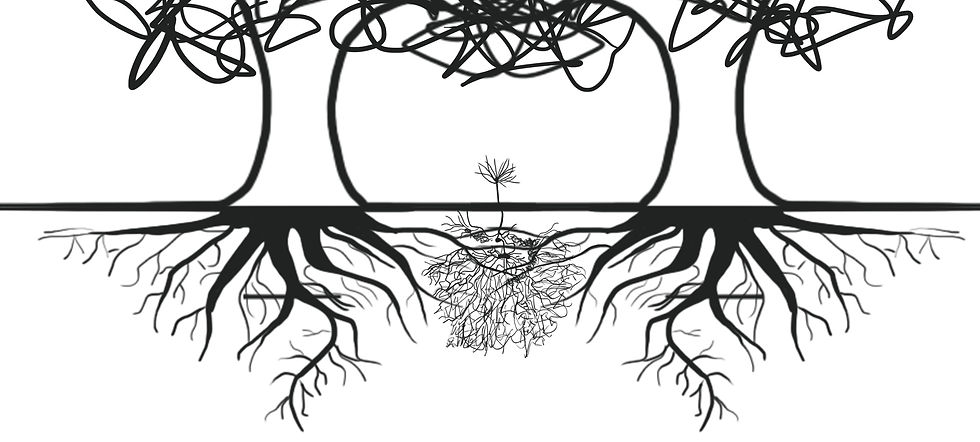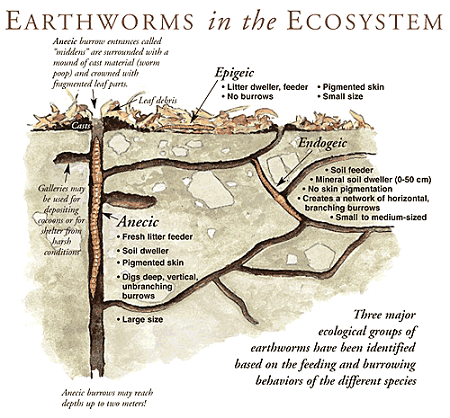•
INTERCONNECT
transitive verb
: to connect with one another
intransitive verb
: to be or become mutually connected
•

Tree roots with Mycorrhizal Networks or mycelium underground.
"There is a much less well-known function that fungi perform within ecosystems, in providing a vast underground supply and communications network. They interconnect with the root systems of plants and trees, passing nutrients, water, and even chemical communication signals between the different organisms. In fact around 90% of all plant species depend on these mutually beneficial mycorrhizal relationships with fungi to survive. This mycorrhizal network creates a subterranean Wood Wide Web within forests, which powers growth, development, and resilience in woodlands and other habitats around the world. The discovery of this symbiotic relationship has the potential to revolutionise our understanding of how organisms interact within ecosystems and how seemingly disconnected plants are in constant communication. We take a look at what fungi are and how they connect all the organisms within a woodland."
(The Wood Wide Web – Why Fungi Are Essential to Forests - Creating Tomorrow’s Forests | Restoring Biodiversity by Creating Habitats and Planting Trees, n.d.)
When I read this paragraph I immediately connected it to my project, the bark, roots, lichen, and slime mould. The way that fungi interconnect with the root system helps the trees thrive in order for the tree to grow bigger and provide a habitat for insects. The whole ecosystem supports and interconnects with each other. I like the phrase "wood wide web" It is like a spider web or a web that silkworms create for their habitat and the forest does exactly the same thing in its own way.

"FIgire 2 Mycorrhizal Networks. Trees communicate with other trees through their mycorrhizal network. Trees who share a mycorrhizal network, like the Birch (left) and Fir (right), are able to send nutrients to each other or signal to each other in times of stress." (SITNFlash, 2022)
"Mushrooms are the fruit of the mycorrhizal network fungus, and connect trees through tiny threads called mycelium." (Underground Networking: The Amazing Connections Beneath Your Feet, n.d.)
SITNFlash (2022) talks about the underground network of trees which works as nervous systems of the forest. "This complex network connecting trees is dependent on a symbiotic relationship with microbes in the soil like fungi and bacteria. Symbiosis is when two separate organisms form a mutually advantageous relationship with each other. Fungi can cover a large surface area by developing white fungal threads known as mycelium. Mycelium spreads out on top of tree roots by up-taking sugars from the tree and by providing vital minerals back to the tree, such as nitrogen and phosphorus (Figure 2)." (SITNFlash, 2022)
I really enjoy reading about the connections that trees make underground with the help of fungi. It is not only humans that try to support each other in stressful times but the trees do the same. The only thing is that we can't see how they communicate because everything is happening underground.
For the trees to survive they need a healthy forest ecosystem which humans are destroying now even if we depend on it for clean oxygen. "Human-initiated deforestation contributes to climate change by reducing the number of trees that are available to soak up carbon dioxide. Deforestation not only removes the trees that are being cut down, but also impacts trees that are still alive by disrupting the mycorrhizal network that is important for intra-tree communication." (SITNFlash, 2022) It is not only a problem that we let out CO2 stored in trees that we cut down but we also destroy valuable connections that are happening underground for the forest's well-being.
"Trees are considered to be the oldest living organisms on the planet. Over centuries, they have been resilient to changes in their environment due to their symbiotic relationship to fungi and other microbes. There are so many more discoveries to be made to understand the ancient wisdom of our forests and the invisible microbes that keep our ecosystems in harmony." (SITNFlash, 2022)

(Worms, n.d.)
"Earthworms are vital to soil health because they transport nutrients and minerals from below to the surface via their waste, and their tunnels aerate the ground." (WATCH: The Largest Earthworm Discovered in UK, n.d.)
There are three different types of categories of earthworms endogeic, anecic and epigeic. "Endogeic worms build latteral burrows, anecic worms build permanent vertical burrows, and epigeic worms feed off of organic matter at the surface of the soil and rarely make deep burrows." (Worms, n.d.) When the earthworms get to work and create the trenches and tunnels (called burrows) they "allow vital nutrients, water, and air to be replaced in the soil and provides space for roots to grow. Worms consume organic material such as leafs, roots, and stems and recycle the nutrients back into the soil. The decomposition of the organic material is vital for soil formation. Without worms, the organic material would not be decomposed properly and soil would not be overturned or replenished with nutrients." (Worms, n.d.)
Understanding the complexity of something that we cant even see is not easy but it is very interesting. It makes you realize that there is so much in nature that we just take for granted, trees will grow back but we will not be able to develop the deep connection that they have to each other with help from fungi again that easily. The best solution is to let nature be and to its own thing.
References:
The Wood Wide Web – Why Fungi Are Essential to Forests - Creating Tomorrow’s Forests | Restoring biodiversity by creating habitats and planting trees. (n.d.). https://www.creatingtomorrowsforests.co.uk/blog/the-wood-wide-web-why-fungi-are-essential-to-forests
SITNFlash. (2022, March 24). Exploring The Underground Network of Trees – The Nervous System of the Forest - Science in the News. Science in the News. https://sitn.hms.harvard.edu/flash/2019/exploring-the-underground-network-of-trees-the-nervous-system-of-the-forest/
Underground Networking: The Amazing Connections Beneath Your Feet. (n.d.). National Forest Foundation. https://www.nationalforests.org/blog/underground-mycorrhizal-network#:~:text=Mycelium%20are%20incredibly%20tiny%20%E2%80%9Cthreads,nitrogen%2C%20carbon%20and%20other%20minerals.
WATCH: The Largest Earthworm Discovered in UK. (n.d.). [Video]. Animals. https://www.nationalgeographic.com/animals/invertebrates/facts/common-earthworm?loggedin=true&rnd=1681896557145
Worms. (n.d.). Ecosystem Services. http://ecoserv.weebly.com/worms.html
Comentarios